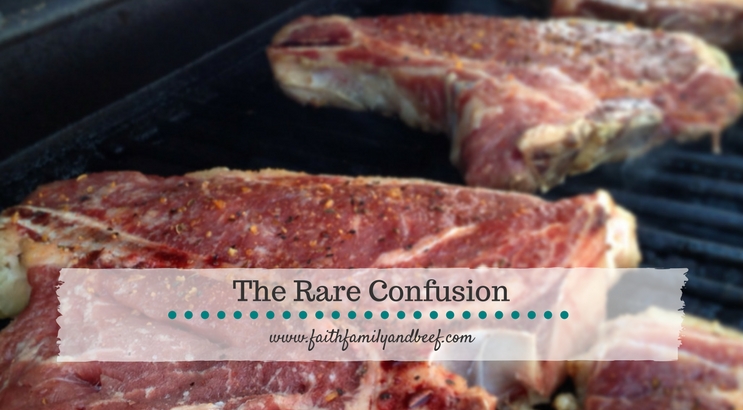Rare – it is my favorite way to enjoy steak. Each juicy bite of tender beef provides an explosion of flavor that is, in my opinion, unmatched by any other food. My mouth is watering just writing about the deliciousness that is a cooked-to-perfection rare steak. So I can understand the desire to consume a burger cooked the same way. BUT – I resist that temptation and must advise you to do the same.
There is this certain level of confusion surrounding what is safe in terms of cooking times, internal temperatures, and levels of doneness across different cuts of beef – a rare confusion, if you will. The human in me wants to place blame on celebrity chefs, and other food influencers, who disregard the rules of food safety whilst advising home cooks. That would be wrong and too easy.
As a raiser of beef, it is also my responsibility to be up-to-date on, and dispersing, the latest in beef safety information. So in an effort to do better, allow me to first explain why I take food safety so seriously, and then dispel some contemporary misconceptions relating to the doneness levels of beef.
You’ve heard me say it before and I will say it again – I am a food safety enthusiast. Basically, this equates to food safety OCD. The health of my family is the biggest reason for my obsessive behavior – that and the fact that I hate throwing up. I especially hate throwing up if I know that it could have been prevented with something as simple as proper cooking. And as a consumer, it is my responsibility to keep up the food safety teamwork I eluded to last week by following the rules.
Now that I’ve given a little insight into what drives my food safety craze, I want to clear up three misconceptions I have been hearing/reading a lot lately.
Misconception – “Rare steak, rare burger – there is no difference.”
Not all cuts of beef are created equal. Cuts such as steaks and roasts are known as whole-muscle cuts. Whole-muscle cuts are those in which the muscle is kept intact, not having been scored (for marinating), tenderized, or ground in any way. The intact nature of whole-muscle cuts keeps any bacteria that may be present isolated to the surface of the meat. Because the bacteria are not present on the inside of steaks and roasts, they are safe to eat once at varying degrees of doneness as long as the outside surface was allowed to reach the bacteria-killing temperature of 160 degrees Fahrenheit.
Burgers, on the other hand, are made from whole-muscle cuts that have been ground. The grinding process brings the outside surface, and any potential illness causing bacteria, in. This means that burgers, and other ground or tenderized cuts, must reach that safe and savory target of 160 degrees throughout,which can only be found using a meat thermometer.
Misconception – “It’s okay because I grind my beef at home, and home-ground beef is better.”
It matters not where beef is ground. The grinding process is still bringing the outside surface of the meat, and any bacteria that is on it, to the inside. To ensure a safe eating experience, all ground beef, regardless of where it was ground, must reach an internal temperature of 160 degrees Fahrenheit.
Misconception – “I only buy organic or grass-finished beef because it is safer.”
False – these options only refer to production type and do not equate to beef safety. The illness causing bacteria show no preference to production style. They will happily reside on meat from an organically raised, or grass-finished animal just the same as they will on meat from animals raised conventionally. The key to safety is proper handling, preparation, and cooking of beef – not how it was raised.
The moral of this food safety story is that only whole-muscle cuts of beef, such as steaks and roasts, are safe to eat at any level of doneness. And all beef that has been tenderized or ground needs to reach a well-done internal temperature of 160 degrees Fahrenheit to guarantee a 100% safe eating experience.


 Hello! I’m Terryn – the wife, mother, food safety enthusiast, Stormy Kromer fanatic who has slightly (okay, a lot) random tendencies, dabbles in photography, and shares (maybe a little too much) here at FFB.
Hello! I’m Terryn – the wife, mother, food safety enthusiast, Stormy Kromer fanatic who has slightly (okay, a lot) random tendencies, dabbles in photography, and shares (maybe a little too much) here at FFB.